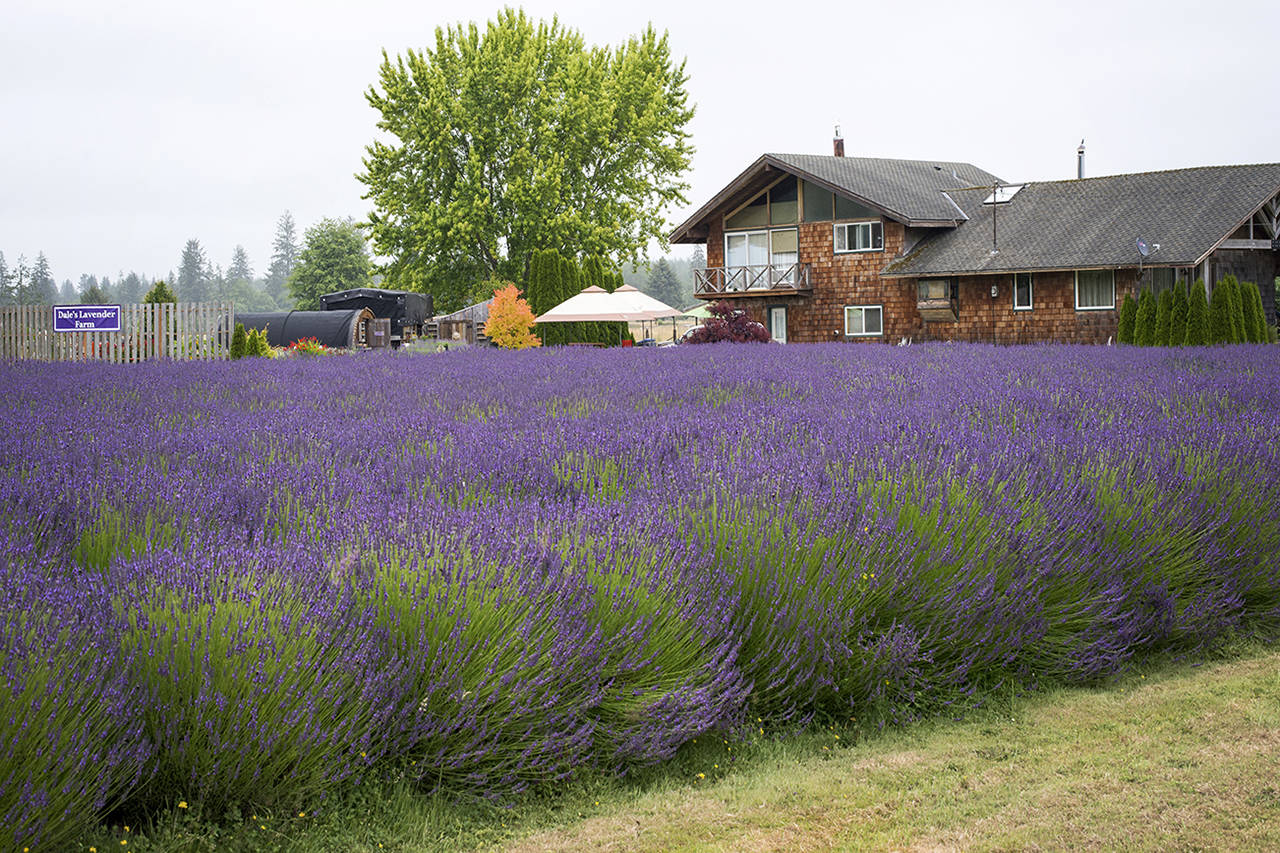By Kat Bryant
Grays Harbor News Group
Dale Dineen didn’t start cultivating lavender to make money.
She’s always loved gardening and appreciated lavender’s relaxing qualities. So when one of her sons was killed in an on-the-job accident in 2009, it seemed natural to combine them to help her through the grieving process.
“After it was all said and done, my husband goes, ‘You want lavender?’ And I said OK,” she says. “Two weeks later, I have 1,000 plants on my porch.”
She threw herself into the task of planting them in the field next to their home, which has been in the Dineen family for multiple generations. She had plenty of help from Tom, her husband of 34 years, and their three surviving adult children.
Once it was all in the ground, it became Dale’s personal labor of love. Tom was a construction manager with the Quinault Indian Nation, and their children were taking care of their own families nearby; so she did nearly all of the work in the field.
She went through the Washington State University Master Gardener program in 2012 to bolster her knowledge, and the lavender flourished.
“It just grew and grew into something bigger,” she says. “After four or five years, it matured and we had to do something with it.”
Building a business
Dale started out selling dried bundles and loose buds to people who stopped by to ask about it. Over time, as word spread and demand grew, she added a variety of homemade products and started operating under the business name Dale’s Lavender Valley.
Tom has stepped up to handle the computer work, which she has no desire to deal with; the field remains her bailiwick. She hires a crew of about seven people to help with the harvest each year, but other than that, she says proudly, “this is all me.”
In their best season to date, she says, the field yielded 6,000 bundles.
At what point should lavender be harvested? “When the first flower buds, that’s when you want to cut it,” she says. “The buds will stay on the stem. But if it blooms (before it’s cut), the flowers will all fall off.”
What Dale chooses to create from her yield changes from year to year. In 2018, in addition to lavender loofah and apple sage soaps, she made lavender room sprays, lip balm, milk bath, sugar scrubs, “wands” and more.
“I do a lot of crafts during the winter, and I can’t keep my soap in stock,” she said. “But my hands can only work so much on those.”
She’s especially fond of the lavender sachets she created last year from recycled wool. They incorporate various color combinations, many with bird, flower or heart motifs. “Sometimes when I make things, I have to keep one for myself,” she says. “They’re just so cute!”
She also sells potted lavender plants for people to place in their own gardens – and not just the Grosso variety that grows in her field. At any given time, customers also might choose from Royal Purple, Sachet, Royal Velvet, Munstead, Melissa, White Dwarf and Alba. These represent a wide spectrum of flowers, from deep purple to bright white. They also have varying levels of aroma and, for those who like cooking with it, taste.
“The reason I like to work with Grosso is that it has the highest oil content — real camphory, real strong,” she says.
Founding a festival
In July 2016, Dale organized her first Lavender Festival — again, not to make money, but because “we needed to sell lavender. We had so much of it!” she laughs. “Plus, we thought it would be fun for the community.
“And again, it just grew.”
She’s adamant that anyone setting up a tent at her festival sell things they’ve actually created. Most of the items sold there have nothing to do with lavender, but that’s not what matters to her.
“It’s all local homemade crafts and products — nothing store-bought,” she says.
She had 20 vendors lining her driveway in 2017 and almost 30 in 2018, including metal arts, baked goods, chocolates, candles and more. She also had live music out by the field, with hay bales to sit on and homemade lavender lemonade to sip.
Her husband and children help out at the event, too, working the cash register and carting purchases out to people’s cars as Dale chats with visitors about her lavender and her crafts.
The Sequim Lavender Festival, which has been going on in Clallam County for 21 years, also takes place in July. It’s a huge event, with corporate sponsorships and well over 100 vendors – but she has no such aspirations for her annual event.
“If you go to Sequim, they’ve got like 300 of the same product on the walls,” she says. “I never want to get that big.”
For love of lavender
Despite how big her operation has become, Dale has no regular employees and doesn’t sell her lavender to commercial concerns. She spends the farm’s meager earnings on “making things better,” she says. “It doesn’t really matter to me whether I make money or not, just because of where it evolved from.”
After nine years, the bottom line is that it’s still a personal journey for her.
“People say, ‘How do you do it?’ You just do it,” she says. “It’s been healing and wonderful, and it’s brought a lot of people into my life. So it’s been good.”
EDITOR’S NOTE: This story originally appeared with many more photos in Washington Coast Magazine, which is printed quarterly by Sound Publishing, parent company of The Daily World. Subscriptions are just $14 per year. For more information, call 360-532-4000.


